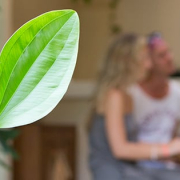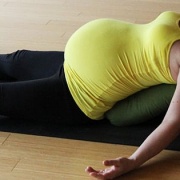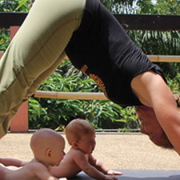 https://samahitaretreat.com/wp-content/uploads/2021/02/nauli-for-women.jpg
533
1000
Gill Breetzke
http://samahitaretreat.com/wp-content/uploads/2024/01/samahita-logo-v2.svg
Gill Breetzke2021-02-08 12:45:002022-11-29 04:35:14Nauli for Women
https://samahitaretreat.com/wp-content/uploads/2021/02/nauli-for-women.jpg
533
1000
Gill Breetzke
http://samahitaretreat.com/wp-content/uploads/2024/01/samahita-logo-v2.svg
Gill Breetzke2021-02-08 12:45:002022-11-29 04:35:14Nauli for Women3 Tips for Teaching the Post-Partum Student

My last article left you at Sirsasana while I was 27weeks pregnant with twins. I had gained 14kg and was feeling fantastic on the mat and off. That 14kg turned into nearly 30 by full-term and Sirsasana became a calculated risk, but I still felt amazing, for the most part.
After our twins arrived, everything changed. I was shocked at how incredibly tired I was. Breastfeeding two newborns, totally sleep deprived and recovering from the birth along with a postpartum hemorrhage that left me anemic, all took its toll on me physically and mentally. I was trashed. I wanted to return to practice. I craved it. At times, I found myself longing for my old life and freedom on the mat. I imagine every new parent experiences something similar once the novelty of the first few days has worn off. It wasn’t until I embraced the change in my life and was ready to show myself a little compassion that I rolled out my mat.
From my experience, and my knowledge of anatomy, I want to share with you some valuable tips for teaching your post-partum students. Before sharing them, I will re-iterate that every woman is different and pregnancies vary. Recommendations on when it’s safe to return to practice vary and are highly dependent on the woman and circumstances around her pregnancy and birth.
Keep the following in mind when teaching asana to any woman after giving birth.
1. Don’t rush it.
Don’t rush the return to the mat and certainly don’t rush things while on the mat.
Returning to the Mat
Although an avid practitioner may be keen to jump on the mat just days after her bundle(s) have arrived, remind her that her body has been through a lot. It takes a few days just to replenish the calories lost during the work of labor and delivery, not to mention the sleep. It’s important to ensure that she has recovered from the initial physical and mental expenditure.
Further, if a woman has suffered any pregnancy induced injuries, it will take even more time. 25% of women experience Symphysis Pubis Dysfuntion during their pregnancy and some continue to have symptoms, indicating that more time is needed, well after birth.
Over 60% of women experience some degree of abdominal separation (diastis recti) in their third trimester or the immediate postpartum period. The gap takes a minimum of 4 weeks to close, and care must be taken when practice is resumed not to increase the gap and prevent healing.
On the Mat
There are many factors at play for the new mother that will affect what she brings to the mat. Sleep deprivation is almost a given in the early days. A sleepy body is a heavy body, so she must listen and approach practice as recovery, rather than something that will add to her lack of energy. Do what feels good. It will take some time to get back to a regular routine. There may also be some specific asana that need to be avoided or modified at first to encourage healing and rest. Encourage her to enjoy each breath she has on the mat as a chance to be healthy and clear her head in order to care for her newborn(s).
2. Let Go…
It is difficult in the beginning to understand that when you have children, you aren’t actually giving up anything . Instead, you are practicing vairagya (non-attachment). It’s ok to let stuff go. Actually, it’s imperative.
Past Self
As a new mother, she must take some time to mourn and let go of her previous life. This is not a bad thing. Babies do change lives and clinging to the “old” identity of “self” doesn’t do anyone any good. A seated practice can be very helpful in taking this needed time, without the physical practice to get in the way of clearing that image, in order to move on and be fully present as a mother.
Expectations of Self
Not only must a new mother let go of what she thinks she should be like in order to be the perfect parent, she must also let go of any expectations she has of her babies. Trying to be everything to everyone is impossible and often a stumbling block for new mothers. It can also assist in brewing post partum depression if a new mom fails to meet her own expectations.
Expectations of Self on the mat
It’s no secret that having a baby or two changes a woman’s body. Even a consistent practice through the entire pregnancy cannot completely combat nature. The body will shift. Some asanas will become impossible, others unsafe. After the birth, some of those same asanas will still be impossible. Possibly, what she was challenged with most physically as a beginner, will be easy and asana that used to be effortless will now require effort. It will take some time to build back the physicality. As her teacher, remind her, there is no rush.
3. Get to know your New Body
A woman’s body does not magically return to it s pre-pregnancy form after giving birth. This means she shouldn’t just pick up with asana where she left off pre-pregnancy. She should start at the beginning; building the foundation of primary series, regardless of what “level” she was at before she got pregnant. Her pelvis will feel different, her hamstrings and hip flexors will inevitably be tight, and if she is breast- feeding, her whole front line will be shortened. Starting at the foundation will assist in correctly realigning her body.
While these tips are extremely important to post-partum practitioners, they only scratch the surface of teaching students experiencing this massive spiritual and anatomical shift.
This June, Elonne and I are teaching “Yoga and the Female Body”, a continuing education course that will cover this and other practice considerations for women in more detail.
More from the Samahita Blog




